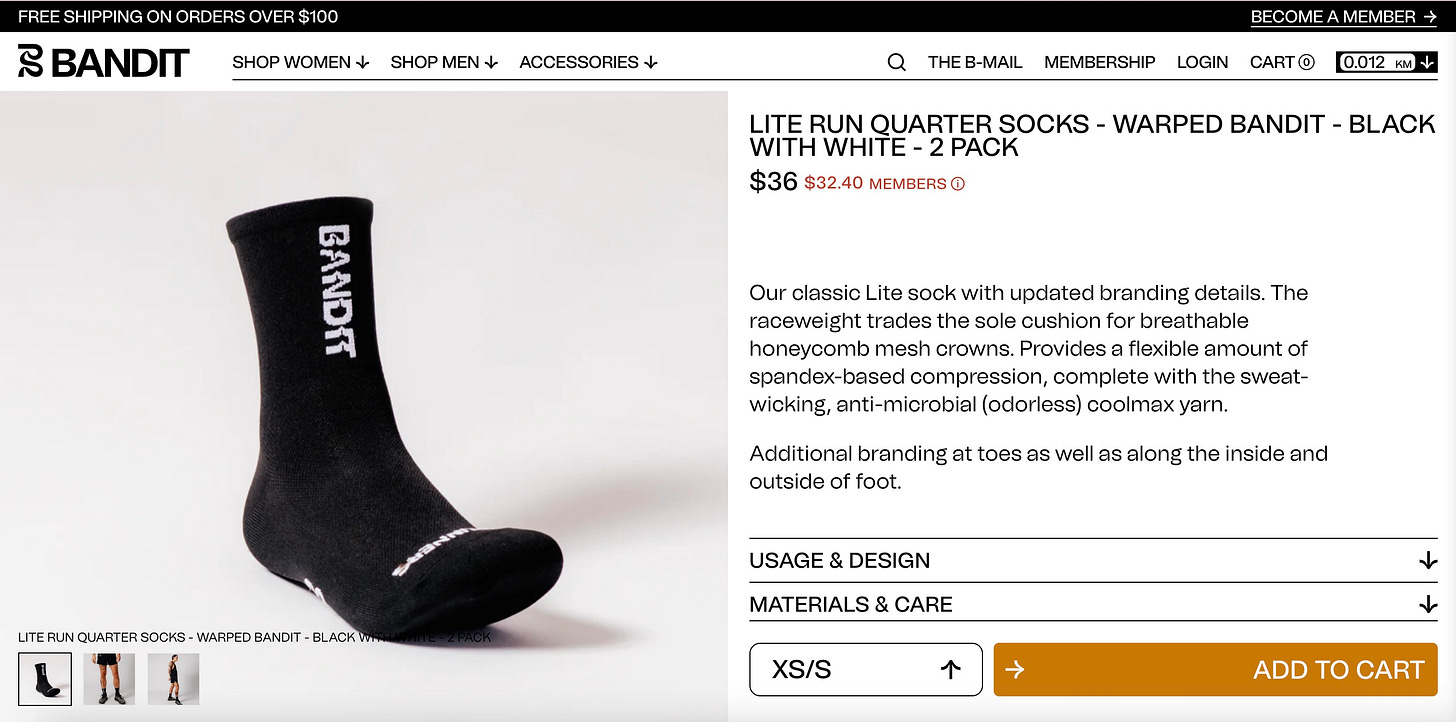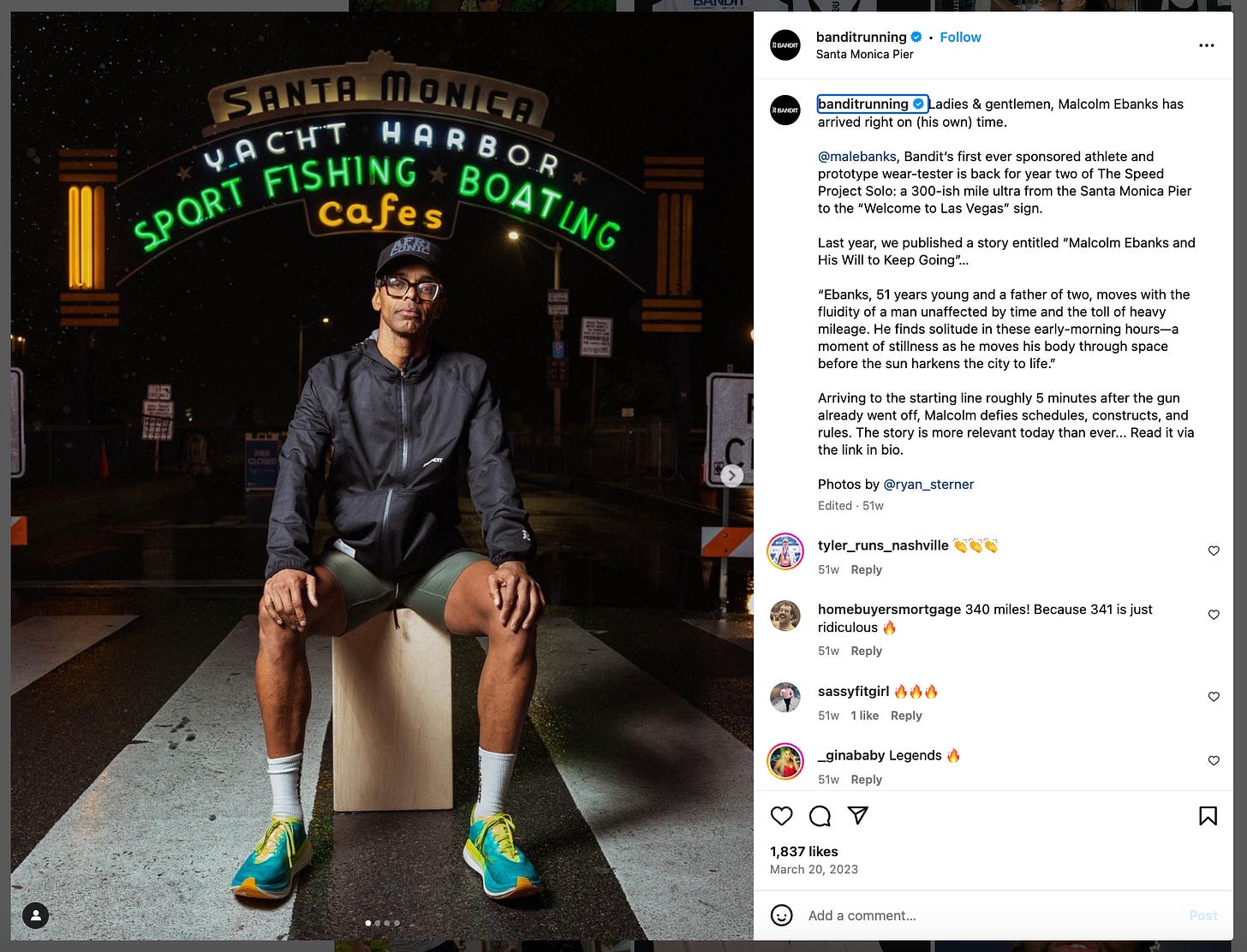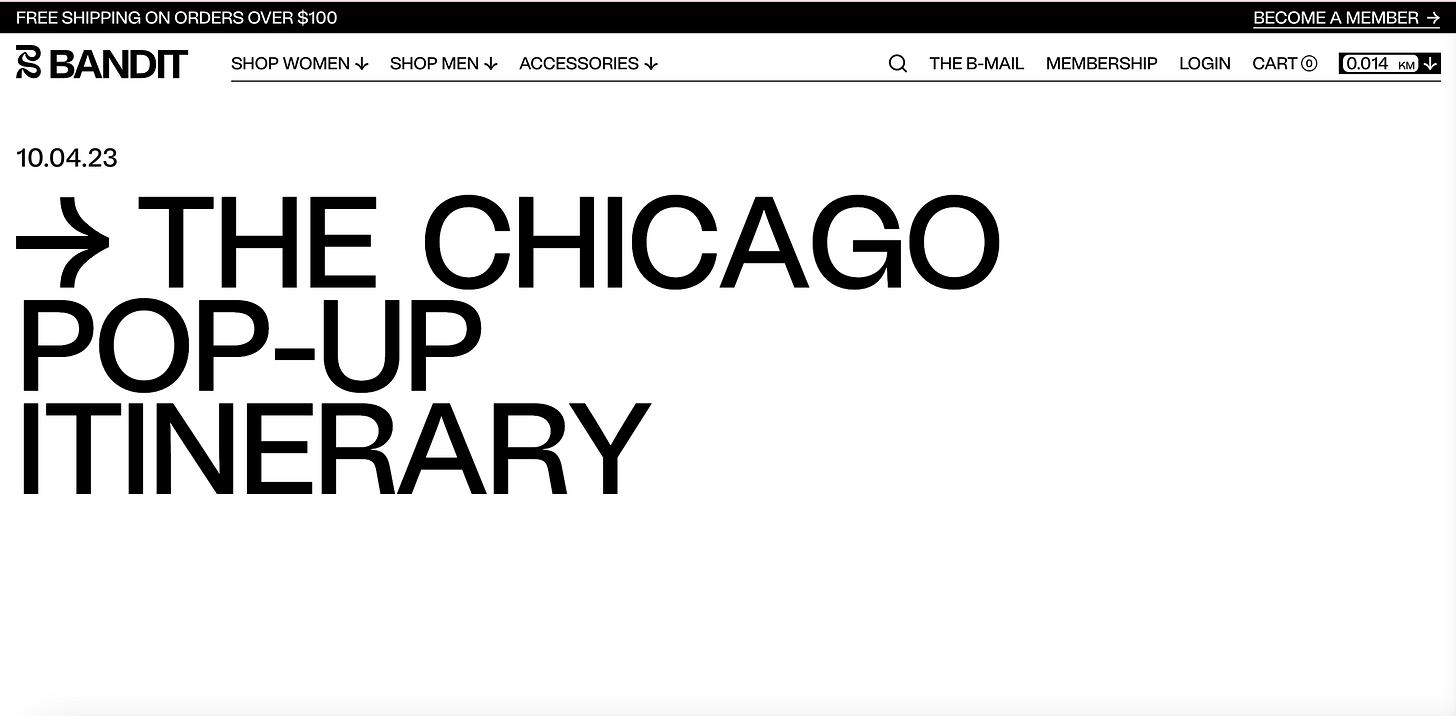How Bandit is Building the Underground Running Brand Taking Over Road Racing Through Community, Storytelling and Event Marketing in just 4 Years
Why acting small can accelerate your growth
Bandit offers a next-gen playbook for community brands that marry crystal clear vision with community immersion to fuel authentic growth
👋 Hi, I'm Amanda. I'm a brand strategist and fractional CMO. I help founder-led businesses turn belief into brand—and brand into a strategic asset that works as hard as you do. I share weekly deep dives with actionable advice on brand building—plus interviews with the people in the trenches. I also work 1:1 with founders and teams. Book a chat here.
Who will love this
Anyone who cringes when brands call their email lists ‘community’
Running nerds who long for (gasp!) fashionable running gear
Community-focused marketers
Today
Good morning!
If I never hear another company refer to their email list as their “community” again, it’ll be too soon. 🤯
I’m not sure when the idea of community became a marketing buzzword, but I can count on one hand the number of brands who harness community well. Two of them are running brands (ayyy Tracksmith).
Today’s brand is Bandit, a community focused running brand out of New York. I’m a runner. I know running brands, and for the most part, they are not cool. IYKYK. Bandit is the opposite.
Bandit is a lesson in building for and with community, thinking small, not being afraid to try things and evolve, and building stories for superusers.
Instead of community as a buzzword, I want us to think about the benefits of community-driven brands as generating understanding. It feels paradoxical to go “slow” like this, but it’s better to go slow in the right direction than move at Mach5 in the wrong one.
4 years in, Bandit have:
Expanded from socks to full apparel line
Built a thriving run club in Greenpoint runners
Launched a membership program with discounts, member events, training programs & swag
Burst onto a relatively crowded running scene and brought a much-needed dose of NYC cool to running apparel
Amassed 6,000 YouTube subscribers who leave comments like this:
“Skipped a meeting to watch this, best running series on YT!”
“What a series. Bandit knows how to do it right. Just signed up for the membership!”
“The FREAKING BEST Olympic trials video out there!!! Thank you so much Bandit for bringing us along and creating this amazing series. So inspiring and congratulations to every single athlete, you guys are incredible!”
On your marks, get set, let’s get into it! 🏃♀️
1. Community First
What Bandit nailed: starting with immersion in the community.
Bandit started as an idea that founder Tim West had when he took up running in 2020. He got a few prototypes of socks made up and started wearing them to his regular, the Brooklyn Track Club.
But he did something interesting. He promised himself he wouldn’t talk about them or ask people to wear them unless ask (have you ever heard a marketer keep quiet about something they’re launching? I’ll wait 🦗). But people liked them. He gave them out to friends and family and got feedback on them. A few sold-out drops later he knew they’d hit on something good.
“Nothing felt NYC to me, nothing felt a reflection of my experience running, so I decided to create a sock and center the brand around the community I was running with on a daily basis. I promised myself I was never going to push the product on anyone or ask anyone to wear it and I wasn’t going to take out a paid ad for the first year. My thinking was - if it’s a good thing, it’ll work itself out.” - Tim West
Most brands get community wrong because they think they are the center of the community. But a community needs to exist in and of itself. Brands that don’t get this will waste a ton of energy (and money). Just yesterday Outdoor Voices announced they’d be closing all their stores (my two cents: community does not exist around something as vague as ‘doing things’).
A year in, Tim & Nick defined the vision and mission behind Bandit and went full-time on the business. Notably, the vision is to be community-driven.
Bandit didn’t start their business by trying to persuade Olympic Trials qualifying runners to star in a docu-series. They didn’t start by producing an entire line of running clothing. They didn’t start with their logo or their launch party (below👇). They started with community.
Here’s what immersion looks like:
Hanging out in the Bandit NY shop and chatting to customers
Posting on instagram: “First person to come to the office can wear test a new product”
Hosting weekly run club events out of the company’s Greenpoint store
So far it’s paying off.
2. Storytelling for the superusers
One of Bandit’s strengths is which stories it tells, and how it tells them, by speaking directly to a hyperspecific target user. And runners by and large not seen themselves reflected in an anodyne running sector.
“I think good creative makes you feel understood” - Tim West
If you want make a really mediocre ad, write it for a persona: 35-45, interested in running, $90-120K income.
If you want to make a winning ad, write it for your superuser: the person who wakes up thinking about running, reads runners biographies in their spare time, signs up for 340 mile running relays, and plans their vacations around their training schedule.
If you are a runner who follows the Olympic marathon trials, you are niche. Bandit tapped into this (arguably underserved) niche by creating the YouTube series “Dialed" following runners in the leadup to the trials. Full disclosure: I’m a runner, I watched this and was so fired up I had to go for a run. They get their target.
Too many companies fail to capture the beauty of what they offer people because they lack the confidence to tell the story well. Bandit marries craft with a hyperspecific target to create a story that transcends the superuser and becomes aspirational for all runners.
As always, the truth is in the comments: this is hyperspecific storytelling that makes people feel something.
Remember: targeting everyone = resonating with no one.
Pick your target. Get to know them. Make them feel something.
3. Events as Marketing
Being a community driven brand means knowing where your people show up. For runners, that’s races.
Bandit maximizes their pop ups and events as a marketing tool by building the infrastructure to capture these people as leads (Eventbrite links are required to RSVP), hosting a killer experience, and broadcasting it out on social. They run live podcasts, shakeout runs (runnerspeak for an easy jog), host post-race portraits, and basically, throw a party post-race.
Unsurprisingly - Bandit see a halo effect of e-commerce spikes from other cities when they’re running race pop ups. But here’s what I love about how Bandit are approaching this: each event has revenue goals, lead goals, and participation goals. Community driven marketing can break the bank if you get swept up in the fun and forget to tie things to revenue goals.
📚 Three lessons to love & learn from
Bandit are a masterclass in doing things that don’t scale, holding a big mission while not being afraid to experiment, and growing by relentlessly focusing on community superusers. Here’s three plays I’d steal from Bandit if I were an early stage marketer focused on building future demand or if I were trying to launch a loyalty or membership program for a set of superfans.
👂Start with a listening tour in a niche community. I’d do this in batches of 8 to 10 people and not stop until you can almost predict what they’re going to say. Get your ear to the ground, baby!
1️⃣ Iterate on one thing until you get signal you’ve met a need. It’s much easier to scale when you hone in on your core business. This post from the John Foraker, former CEO of Annies was a good reminder: obsession with the core, then scaling, works.
🛠️ Make strategic investments in your community that don’t scale. Bandit’s event marketing is a good example of this. If you find yourself saying “there’s no way we can do this for everyone when we hit X customers,” that’s a good thing (but please, measure your investment, tie it to business goals be smart) Your job right now is to help every single person in your niche build an incredible relationship with your brand and product, and make them feel like you represent them.
💪 Let’s build better brands and businesses
If you’re ready to take your brand to the next level, here are 3 things I’m doing that can support you.
Need a hand growing your brand? That’s what I do. Reply to this email to book an obligation free chat.
I share brand and marketing lessons on LinkedIn a few times a week. Click here to follow me.
I’m interviewing experts on brand measurement and putting together a practical guide tailored by stage of business. To get the deep-dive, click here.
That’s all! ✌️ Thanks for your time.
Amanda
What did you think of today’s newsletter?












